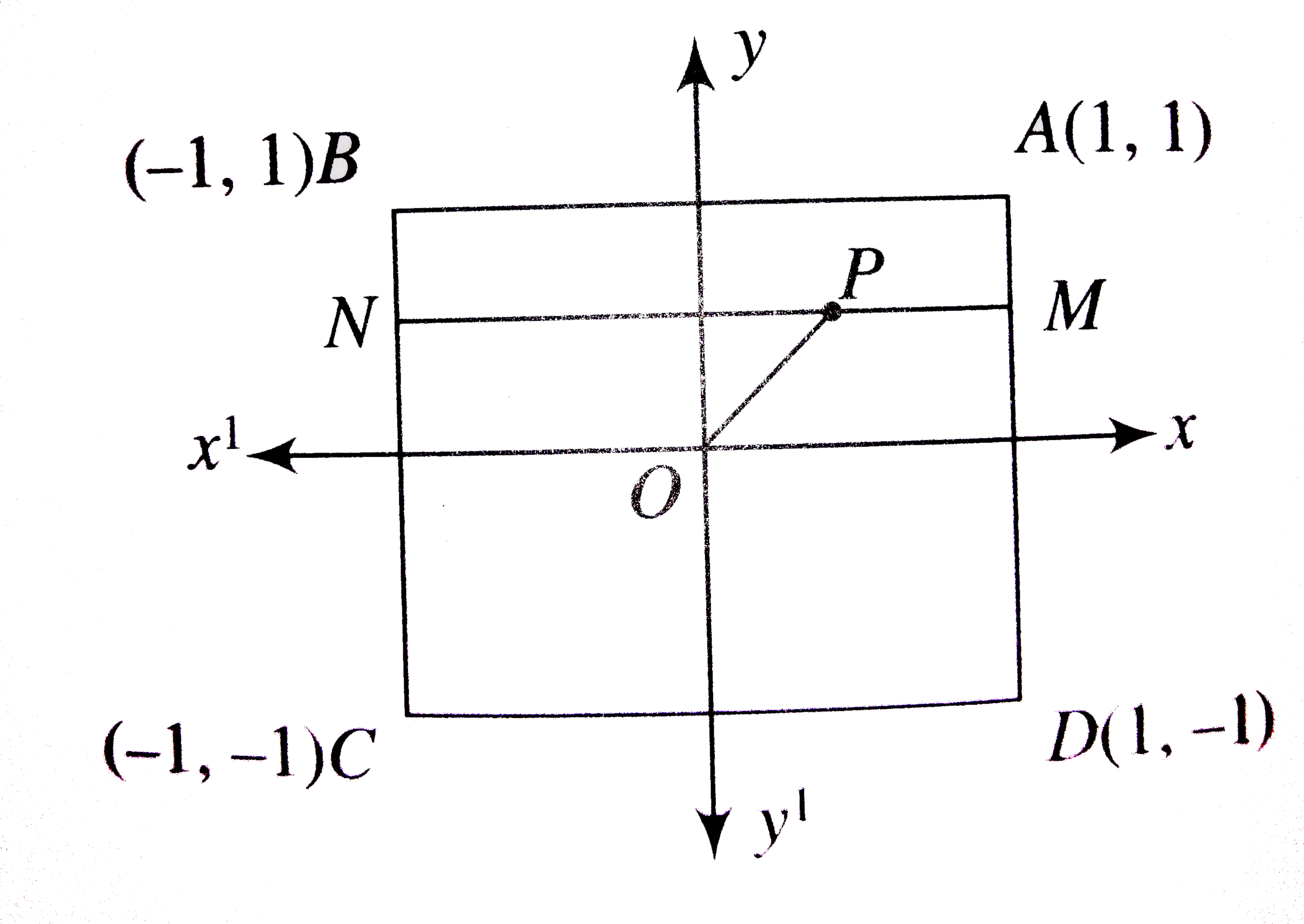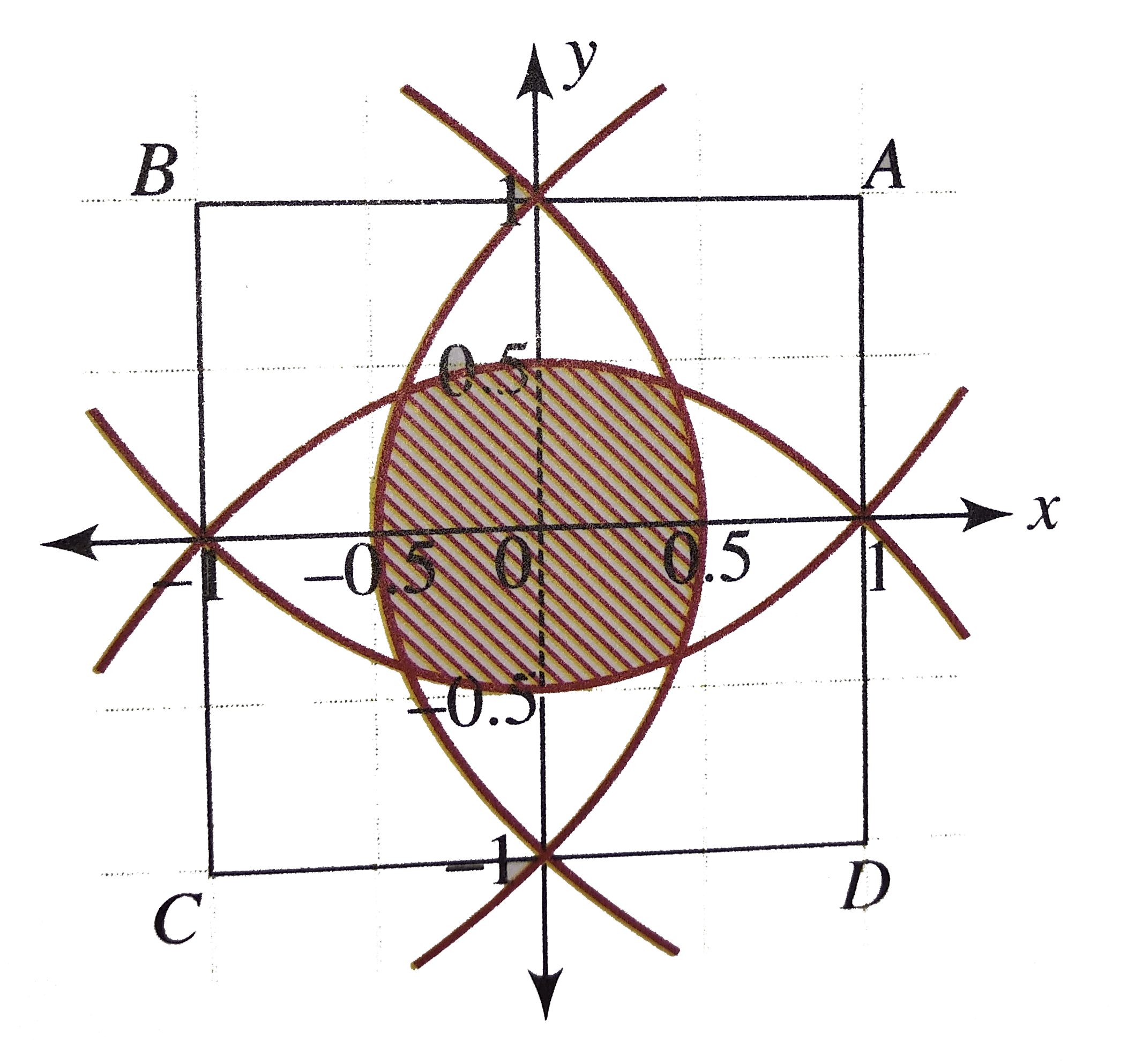Consider a square with vertices at (1,1),(−1,1),(−1,−1),and(1,−1). Set S be the region consisting of all points inside the square which are nearer to the origin than to any edge. Sketch the region S and find its area.Solution in Bengali
Let us consider any point (x,y) inside the square such that its distance from the origin ≤ its distace from any of the edges, say AD.
∴ OP<PM
⇒ √(x2+y2)<1−x
⇒ y2≤−2(x−12) (i)
Above represents all points within and on the parabola P1.
If we consider the edges BC, then OP<PN will imply
y2≤2(x+12) (ii)
Similarly, if we consider the edges AB and CD, we will have
x2≤−2(y−12) (iii)
x2≤2(y+12) (iv)
Hence S consists of the region bounded by the four parabolas meeting the axes at (±12,0)and(0,±12).


Topper's Solved these Questions
- GRAPHS OF ELEMENTARY FUNCTIONS BOOK - CENGAGE PUBLICATIONCHAPTER - GRAPHS OF ELEMENTARY FUNCTIONS EXERCISE - EXERCISES
33 Videos
- GRAPHS OF POLYNOMIAL AND RATIONAL FUNCTIONSBOOK - CENGAGE PUBLICATIONCHAPTER - GRAPHS OF POLYNOMIAL AND RATIONAL FUNCTIONSEXERCISE - Exercises
16 Videos
- GRAPHS OF TRIGONOMETRIC FUNCTIONSBOOK - CENGAGE PUBLICATIONCHAPTER - GRAPHS OF TRIGONOMETRIC FUNCTIONSEXERCISE - Exercises
22 Videos
Similar Questions
Draw the graph of y=1(1/x).
View SolutionDraw the graph of y=(x−1)(x2−x+1).
View SolutionDraw the graph of y= cosec 2x−cot2x. Is f(x) periodic ? If yes, what is its fundamental period ?
View SolutionThe co-ordinates of the extremities of one diagonal of a square are (1,1) and (1,-1) Find the co-ordinates of its other vertices and the equation of the other diagonal
View SolutionFind the equation of the ellipse that passes through the origin and has the foci at the points (−1,1)andS'(1,1).
View SolutionThe points A(5,−1,1),B(7,−4,7),C(1,−6,10)andD(−1,−3,4) are the vertices of a (A) rhombus (B) square (C) rectangle (D) none of these
View SolutionConsider two regions
R1:points P are nearer to (1,0) than to x=−1.
R2:Points P are nearer to (0,0) than to (8,0) Find the area of the region common to R1andR2.
View Solutionबिन्दुओ(1,1),(1,−1),(−1,1) और से बने त्रिभुज के क्षेत्रफल……….. वर्ग इकाई है ।
View SolutionConsider a square with vertices at (1,1)(−1,1)(−1,−1)and(1,−1). Let S be the region consisting of all points inside the square which are nearer to the origin than to any edge. Sketch the region S and find its area.
View SolutionFind the product [−1−1−11][1111]
View Solutionमाना वर्ग के शीर्ष (1,1),(−1,1),(−1,−1) तथा (1,−1) है | माना वर्ग के अन्दर के सभी बिन्दुओ मूल बिन्दु से किसी भी भुजा कि अपेक्षा पास हो, का क्षेत्र S है | S को क्षेत्र बनाइए तथा इसका क्षेत्रफल ज्ञात कीजिए |
View SolutionConsider a square with vertices at (1,1)(−1,1)(−1,−1)and(1,−1). Let S be the region consisting of all points inside the square which are nearer to the origin than to any edge. Sketch the region S and find its area.
View SolutionConsider a square with vertices at (1,1),(−1,1),(−1,−1),and(1,−1). Set S be the region consisting of all points inside the square which are nearer to the origin than to any edge. Sketch the region S and find its area.
View SolutionConsider a square with vertices at (1,1),(−1,1),(−1,−1),and(1,−1). Set S be the region consisting of all points inside the square which are nearer to the origin than to any edge. Sketch the region S and find its area.
View SolutionConsider two regions
R1:points P are nearer to (1,0) than to x=−1.
R2:Points P are nearer to (0,0) than to (8,0) Find the area of the region common to R1andR2.
View SolutionFind the distance between the following pairs of point:Q(3,2,−1)and B(−1,1,−1).
View Solution

